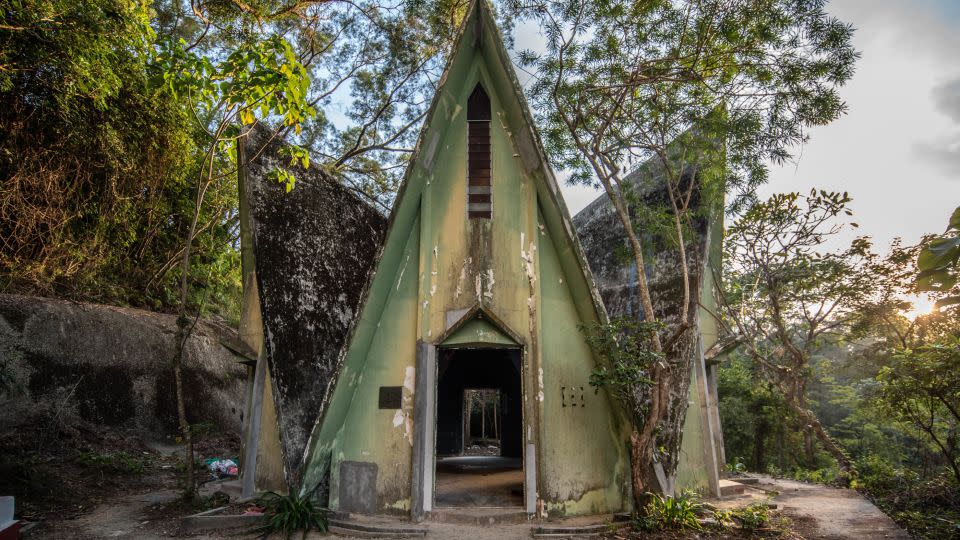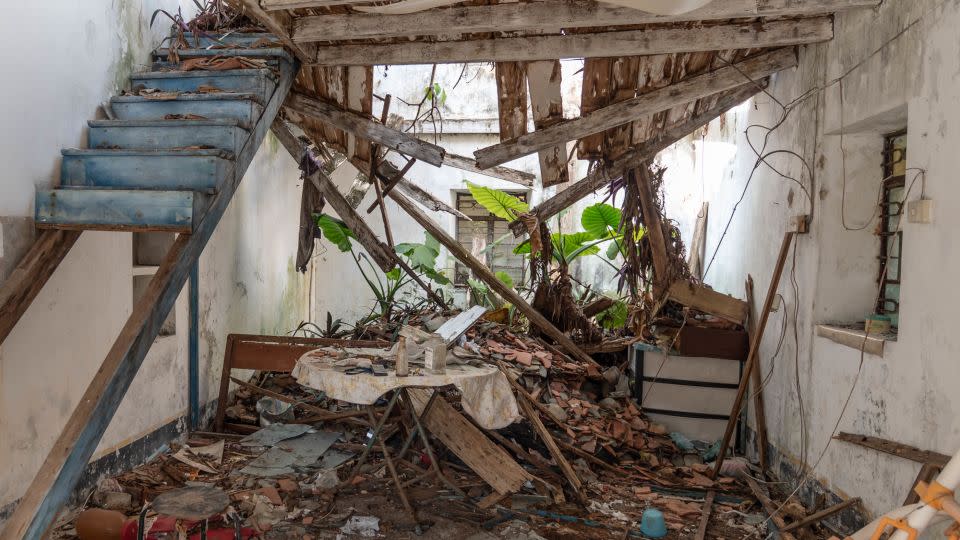In Hong Kong, abandoned villages have been reclaimed by nature
Thick roots tumble across a dilapidated house, the snake-like trunks of a banyan tree framing where the front door once stood. Its walls have been hollowed by decades of typhoons, monsoons and summer humidity, now little more than loose, moss-covered stones and mortar dust. Vines tease through cracks in the foundations and fallen leaves litter the rotten floorboards.
This scene wouldn’t look out of place deep in the Malaysian rainforest or the verdant foothills of India. But photographer Stefan Irvine snapped these pictures just a stone’s throw from the center of one of the most densely populated cities in the world, a global metropolis of steely skyscrapers and gridlocked traffic.
Irvine, who has lived in Hong Kong since 2002, first stumbled across the city’s abandoned villages in 2012 while visiting a friend in the New Territories, a vast area to the city’s north. Accounting for over 85% of Hong Kong’s territory, the district is characterized by steep mountains, long stretches of rugged coastline and tree-covered country parks.
“It made me question, ‘Why (were) so many of these places vacant in a place like Hong Kong, where the property prices are the highest in the world?’” Irvine recalled. Over the next 12 years, the London-born photographer explored more of these abandoned villages, documenting what would become the subject of his new book, “Abandoned Villages of Hong Kong.”
“It’s opened my eyes to a different aspect of Hong Kong,” said Irvine. “That’s what I’m hoping the project will do for other people as well.”

Trading farming for factories
Although Irvine took the first image for the project — an abandoned home with plants spilling out onto the road through a yellow door frame — in 2012, it wasn’t until 2019 that he began actively hunting down locations to photograph.
“These villages have existed in Hong Kong for hundreds of years, way before the colonial period,” explained Irvine. In the 1950s and ‘60s, as Hong Kong grew as an industrial hub, many people migrated to the rapidly expanding urban centers for better working opportunities. “It’s hard farming and fishing out there in these remote areas, so a lot of people moved to the city to work in the factories,” he added.
Through library research, the 48-year-old photographer found people who grew up in the villages or had relatives who lived there. In the book, he included essays from two women connected to the village: one whose father grew up in Wong Chuk Shan village, now completely overgrown, and another who spent several years of her childhood in Lai Chi Wo village, on the northeast coast of Hong Kong in the 1970s.
“Now she lives in the UK with her own family, but she comes back to visit HK every few years, and still feels a deep sense of connection with Lai Chi Wo,” Irvine said of the latter woman, adding: “You can tell they feel an intense bond with their ancestors and with the village itself.”
While many of the villages emptied out slowly over decades, Irvine found some homes that appeared to have been “abandoned pretty rapidly,” with personal items and furniture left behind.

“There were calendars on the wall, school certificates in drawers — it’s quite poignant,” said Irvine.
“I think a lot of people left with the intention of coming back one day, or maybe retiring back in the village. But if you don’t maintain these properties, eventually they’ll succumb to nature. Termites will start to burrow their way into the wooden beams. If one of those collapses, then the seeds can fall in from trees and plants, and then they really take over.”
Rotting floorboards and unstable masonry made some of the building dangerous to explore. For Irvine, the biggest risk was posed by territorial village dogs that often became aggressive as he walked through remote areas. “I started the habit of carrying dog biscuits in my camera bag when I went out to these places,” he said.
The project took Irvine to the furthest reaches of the city, using minibuses and ferries to access isolated towns and islands. One adventure saw him embark on a six-hour round trip to Tung Ping Chau, a far-flung island closer to the Chinese mainland than to Hong Kong. Once a thriving fishing and farming community, most residents left the island in the 1960s to make a living in the city. Irvine ended up using just one image from the trip in his book — but the trip was “totally worth it,” he said.

Heritage value
While most of the villages Irvine photographed are abandoned, he was surprised to discover not all were.
“I would hike for about an hour into the wilderness to find a beautiful old village and I assumed there would be nobody there — and then around the corner would be someone with a wheelbarrow on their way to plant vegetables or something. So that was a bit of a shock,” he said.
Two of his favorite locations to shoot — Luk Keng, a coastal area near the border with Shenzhen in mainland China, and Lai Chi Wo, a remote 400-year-old Hakka village accessible only by boat or a two-hour hike through the forest — are both still home to small communities.
“Lai Chi Wo is quite interesting because (Hong Kong’s) government has realized the heritage value in this village and they’ve invested a substantial amount of money to revitalize some of the old buildings,” said Irvine. “They want to encourage young people to go out there and stay overnight and to experience a different side of Hong Kong.”
Irvine found other deserted villages that were also being revitalized for tourism. Yim Tin Tsai, a former catholic missionary outpost and salt farming community, is completely abandoned — but every summer, it hosts an art installation and festival.

“People take a little sampan (a flat-bottomed boat) across the water, it’s 15 minutes away from (the coast), and they can interact with these art installations that use some of the abandoned sites to great effect,” Irvine said.
Irvine believes there is a growing sentimentality and nostalgia among Hong Kong’s people “to save and relish their built heritage.” These rural sites are a key part of that, he said, adding: “I think it’s of great value to people and their sense of identity.”
The photographer’s book, published this month alongside an accompanying exhibition in Hong Kong, aims to “preserve for posterity” this built heritage. And while Irvine’s pictures speak to a loss of community, he views them as a “celebration” of nature, too.
Hong Kong is one of the most biodiverse cities in the world, and its villages, which were often built around natural features and relied on the land, are a microcosm of that. Tucked between the mountains and the sea, the Hakka village at Lai Chi Wo, for instance, features mature woodlands, freshwater streams, agricultural wetlands, mud flats and mangroves.
“At the end of the day, nature will eventually take over,” Irvine said. “It’s a reminder of the impermanence that we all experience: Things come and go, nothing endures really.”
“Abandoned Villages of Hong Kong,” published by Blue Lotus Editions, is available now. An accompanying exhibition is on show at Hong Kong’s Blue Lotus Gallery until Feb. 25, 2024.
For more CNN news and newsletters create an account at CNN.com


